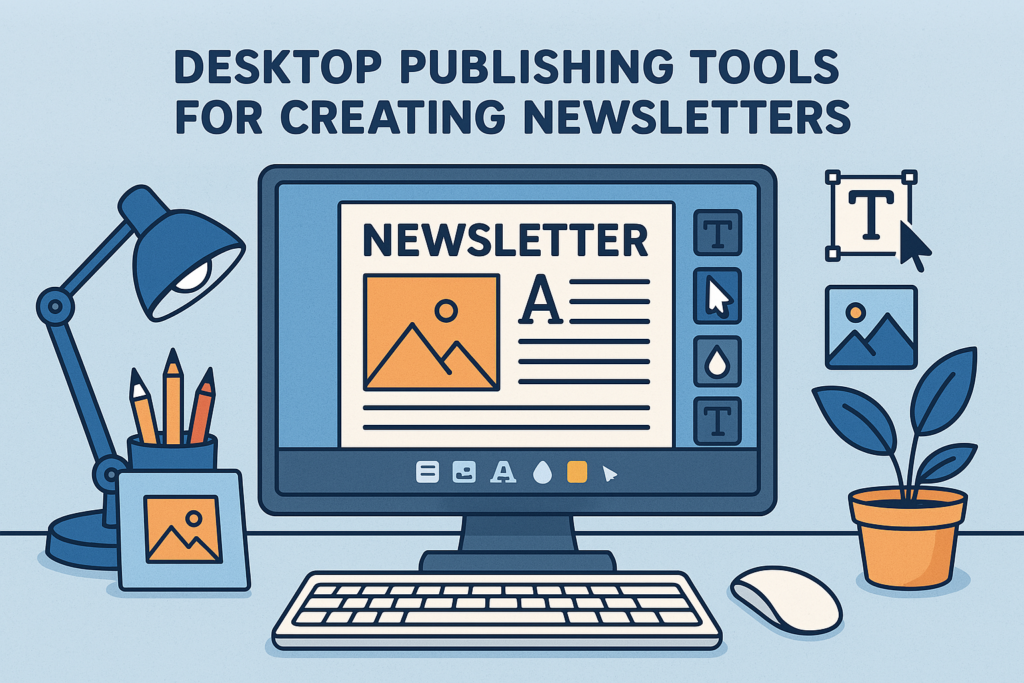Are you looking for top publishing tools for newsletters? Creating captivating and professional newsletters is vital for businesses, organizations, and individuals who wish to connect effectively with their audience. The correct desktop publishing tools may make the process of generating, customizing, and sending newsletters considerably easier, especially for individuals without substantial graphic design knowledge. This blog analyzes the finest desktop publishing tools for writing newsletters, covering their features, advantages, and recommendations for making your newsletters stand out.
Why Use Desktop Publishing Tools for Creating Newsletters?
Desktop publishing (DTP) tools are software applications that allow users to create and produce high-quality printed or digital documents. When it comes to newsletters, these tools offer numerous major benefits:
Increased productivity: They streamline the design process, allowing you to create professional-looking newsletters faster.
Improved appearance: Desktop publishing software helps you to develop visually appealing layouts that capture readers’ attention.
Customization: You may adapt newsletters to your brand’s colors, typefaces, and style, assuring consistency and professionalism.
Cost-effectiveness: Many tools decrease the need for employing expert designers or printing services, saving money.
Ease of use: Modern technologies generally come with templates and drag-and-drop interfaces that simplify newsletter authoring for novices.
With these advantages, choosing the correct desktop publishing solution is vital to optimizing your newsletter’s impact.
Top Publishing Tools for Newsletters
1. Adobe InDesign
Adobe InDesign is the industry standard for professional desktop publishing. It features powerful layout and typography capabilities, making it excellent for sophisticated mail designs.
Pros: Highly adaptable, enables multi-page layouts, works nicely with Adobe Photoshop and Illustrator for complex graphics.
Cons: Steep learning curve, subscription-based pricing.
Best for: Users with design knowledge who desire full creative control.
2. QuarkXPress
QuarkXPress is a veteran desktop publishing software known for its robust layout and design capabilities, making it a strong contender for creating professional newsletters.
Pros: It offers precise typography controls, supports complex multi-page documents, has strong color management, and has a no-subscription, one-time purchase option.
Cons: The interface can feel dated compared to newer tools, there is less integration with other creative software, and a moderate learning curve.
Best for: Experienced designers and publishers seeking a powerful, standalone desktop publishing solution without ongoing subscription fees.
3. Microsoft Publisher
Microsoft Publisher is a user-friendly desktop publishing program that is part of the Microsoft Office suite.
Pros: It is easy to use, ideal for simple to somewhat complicated newsletters, and connects with other Microsoft Office apps.
Cons: Limited sophisticated design features compared to Adobe InDesign.
Best for: Small enterprises and individuals familiar with Microsoft Office.

4. LucidPress
LucidPress is a web-based design tool that includes drag-and-drop capabilities and professional themes.
Pros: Intuitive UI, cloud-based collaboration, and brand asset management to keep newsletters on-brand.
Cons: Some features require a paid subscription.
Best for: Teams wanting collaborative newsletter creation with brand consistency.
5. Scribus
Scribus is a free, open-source desktop publishing application.
Pros: It has powerful capabilities equivalent to commercial software, supports professional publishing standards, and is free to use.
Cons: The interface can be less polished, and there is a learning curve for novices.
Best for: Budget-conscious users who seek professional outcomes without cost.
6. Visme Newsletter Maker
Visme offers an online newsletter builder with a rich library of templates and drag-and-drop editing.
Pros: Easy to customize templates, AI-assisted design elements, perfect for print and digital newsletters.
Cons: Some sophisticated features are behind a paywall.
Best for: Users looking for quick, visually appealing newsletters without design skills.
7. Marq (previously Lucidpress)
Marq is an easy-to-use online newsletter builder with a focus on brand consistency and multi-channel distribution.
Pros: Smart templates, drag-and-drop editor, team collaboration, supports print and digital formats.
Cons: Requires account login; some features are paid.
Best for: Businesses requiring professional newsletters with team input and brand control.
Tips for Designing Effective Newsletters Using Desktop Publishing Tools
1. Plan Your Content Ahead
Gather and organize all your mailing content before commencing your design. Knowing your content, graphics, and essential messaging helps you select the correct template and layout.
2. Use Templates Wisely
Templates save time and offer a professional look. Choose templates that fit your content and brand style, then edit colors, fonts, and photos to make it your own.
3. Maintain Brand Consistency
Use your business’s colors, logos, and fonts consistently across the newsletter to establish brand identity and build trust with your audience.
4. Prioritize Readability and Visual Hierarchy
Use legible fonts and sizes, and structure text using headings, subheadings, and bullet points. Visual hierarchy helps readers through your message and highlights crucial information.
5. Optimize for Print and Digital
If you wish to publish your newsletter, design it at high resolution (at least 300 dpi) and use CMYK color mode. For digital distribution, ensure your newsletter is mobile-friendly and loads quickly.
6. Include Clear Calls to Action (CTAs)
Every newsletter should have a purpose—whether it’s driving traffic, marketing a product, or sharing news. Use different, easy-to-find CTAs to boost reader engagement.
7. Proofread and Test
Always review your material for typos and test your newsletter on numerous devices and email applications to guarantee uniform appearance and functionality.
Conclusion
Desktop publishing tools have really changed the way companies, groups, and people produce and distribute newsletters. Newsletters are still a great tool for developing relationships, distributing useful material, and advertising goods or services in the fast-paced digital environment of today. Thanks to a vast array of desktop publishing tools accessible, from professional-grade software like Adobe InDesign and QuarkXPress to user-friendly web platforms including Visme and Marq, anyone can design sophisticated, visually appealing newsletters regardless of their design background.
There is a desktop publishing tool catered to your particular requirements and budget, whether you are a novice searching for basic drag-and-drop answers or a seasoned graphic designer seeking complete creative freedom. These instruments not only streamline the design process but also help preserve brand consistency, increase readability, and maximize newsletters for print and digital media.
Creating newsletters that really appeal to your readers depends on using the correct desktop publishing program and following the best standards in layout, typeface, and content arrangement. Engaging newsletters may all achieve effective message delivery, more client loyalty, and more participation.
Don’t wait to improve your newsletter game-start exploring these desktop publishing tools immediately and create newsletters that leave a lasting impression and propel actual outcomes for your company or brand.

